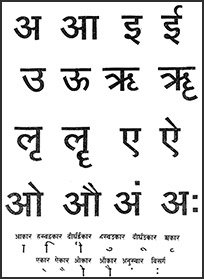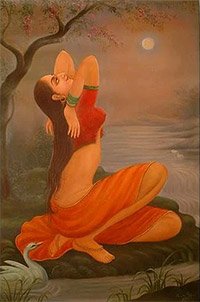Visheshaka, Viśeṣaka, Visesaka: 15 definitions
Introduction:
Visheshaka means something in Hinduism, Sanskrit, Buddhism, Pali, Marathi. If you want to know the exact meaning, history, etymology or English translation of this term then check out the descriptions on this page. Add your comment or reference to a book if you want to contribute to this summary article.
The Sanskrit term Viśeṣaka can be transliterated into English as Visesaka or Visheshaka, using the IAST transliteration scheme (?).
In Hinduism
Vyakarana (Sanskrit grammar)
Source: Wikisource: A dictionary of Sanskrit grammarViśeṣaka (विशेषक).—Determining: determinant; cf. अस्त्यत्र विशेषः । राजा विशेषकः प्रयुज्यते तेन विशिष्टस्यानयनं भवति (astyatra viśeṣaḥ | rājā viśeṣakaḥ prayujyate tena viśiṣṭasyānayanaṃ bhavati); M. Bh. on P.II. 2.6; cf. अवयवे कृतं लिङ्गं समुदायस्य विशेषकं भवति (avayave kṛtaṃ liṅgaṃ samudāyasya viśeṣakaṃ bhavati); M.Bh.on P.I.3.62 Vārt.5.

Vyakarana (व्याकरण, vyākaraṇa) refers to Sanskrit grammar and represents one of the six additional sciences (vedanga) to be studied along with the Vedas. Vyakarana concerns itself with the rules of Sanskrit grammar and linguistic analysis in order to establish the correct context of words and sentences.
Kavyashastra (science of poetry)
Source: Shodhganga: Bhismacaritam a critical studyViśeṣaka (विशेषक) refers to a “combination of three sentences” as employed in the Bhīṣmacarita (Bhishma Charitra) which is a mahākāvya (‘epic poem’) written by Hari Narayan Dikshit.—Madhusudan Mishra rightly observes that the poet is at liberty to choose his favourite metre to begin a canto, he also has to observe the restriction to continue it in spite of all odds. That is to say, sometimes the metre in hand may look too tiny before the elaborate ideas and the poet may face the situation of a square peg in round hole, but there is no alternative before the poet other than continuing the one at the beginning. The early poets must have felt such difficulties in their works, but soon they could have got through it by devising some tricks like yugma, sandanitaka, kalāpaka, kūlaka, etc. in which a number of stanzas are connected with one another as forming one sentence

Kavyashastra (काव्यशास्त्र, kāvyaśāstra) refers to the ancient Indian tradition of poetry (kavya). Canonical literature (shastra) of the includes encyclopedic manuals dealing with prosody, rhetoric and various other guidelines serving to teach the poet how to compose literature.
Kama-shastra (the science of Love-making)
Source: Shodhganga: Elements of Art and Architecture in the Trtiyakhanda of the Visnudharmottarapurana (kama)Viśeṣaka (विशेषक) refers to “different (designs)” (for decorating the forehead).—Cf. Viśeṣakacchedya [= viśeṣakacchedyaṃ], which refers to “cutting of different designs on Bhūrjapatra for decorating the forehead”, representing one of the “sixty four kinds of Art”, according to the Kāmasūtra of Vātsyāyaṇa.—Indian tradition, basically includes sixty four Art forms are acknowledged. The references of sixty four kinds of kalā are found in the Bhāgavatapurāṇa, Śaiva-Tantras, Kāmasūtra of Vātsyāyaṇa etc.

Kamashastra (कामशास्त्र, kāmaśāstra) deals with ancient Indian science of love-making, passion, emotions and other related topics dealing with the pleasures of the senses.
Languages of India and abroad
Pali-English dictionary
Source: BuddhaSasana: Concise Pali-English Dictionaryvisesaka : (m.) a distinguishing mark.
Source: Sutta: The Pali Text Society's Pali-English DictionaryVisesaka, (m. or nt.) (fr. visesa) 1. a (distinguishing) mark (on the forehead) Vin. II, 267 (with apaṅga).—2. leading to distinction VvA. 85. (Page 641)

Pali is the language of the Tipiṭaka, which is the sacred canon of Theravāda Buddhism and contains much of the Buddha’s speech. Closeley related to Sanskrit, both languages are used interchangeably between religions.
Marathi-English dictionary
Source: DDSA: The Molesworth Marathi and English Dictionaryviśēṣaka (विशेषक).—n S A trio of stanzas connected by the construction, the three together completing the sense.
Marathi is an Indo-European language having over 70 million native speakers people in (predominantly) Maharashtra India. Marathi, like many other Indo-Aryan languages, evolved from early forms of Prakrit, which itself is a subset of Sanskrit, one of the most ancient languages of the world.
Sanskrit dictionary
Source: DDSA: The practical Sanskrit-English dictionaryViśeṣaka (विशेषक).—a.
1) Distinguishing, distinctive.
2) Restrictive; ननु विशेषकः शब्दः श्रूयते ब्रह्मवर्चसकमिति । नैष विशेषकः । उपाधिकर एषः (nanu viśeṣakaḥ śabdaḥ śrūyate brahmavarcasakamiti | naiṣa viśeṣakaḥ | upādhikara eṣaḥ) | ŚB. on MS.4.3.2.
-kaḥ, -kam 1 A distinguishing feature or characteristic, an attribute.
2) A discriminative or distinguishing quality.
3) A mark on the forehead with sandal, saffron &c.
4) Drawing lines of painting on the face and person with coloured unguents and cosmetics; प्रत्याख्यातविशेषकं कुरबकं श्यामाव- दातारुणम् (pratyākhyātaviśeṣakaṃ kurabakaṃ śyāmāva- dātāruṇam) M.3 5; स्वेदोद्गमः किंपुरुषाङ्गनानां चक्रे पदं पत्रविशेषकेषु (svedodgamaḥ kiṃpuruṣāṅganānāṃ cakre padaṃ patraviśeṣakeṣu) Kumārasambhava 3.33; R.9.29; Śiśupālavadha 3.63;1.84.
-kaḥ A particular form of speech; cf. विशेषोक्ति (viśeṣokti).
-kam A group of three stanzas forming one grammatical sentence; द्वाभ्यां युग्ममिति प्रोक्तं त्रिभिः श्लोकैर्विशेषकम् । कलापकं चतुर्भिः स्यात्तदूर्ध्वं कुलकं स्मृतम् (dvābhyāṃ yugmamiti proktaṃ tribhiḥ ślokairviśeṣakam | kalāpakaṃ caturbhiḥ syāttadūrdhvaṃ kulakaṃ smṛtam) ||.
Source: Cologne Digital Sanskrit Dictionaries: Shabda-Sagara Sanskrit-English DictionaryViśeṣaka (विशेषक).—mfn.
(-kaḥ-kā-kaṃ) Discriminative, distinguishing, attributive, characteristic. mn.
(-kaḥ-kaṃ) 1. A mark on the forehead made with Sandal, &c. and worn either as an ornament or sectarial distinction. 2. An attribute, a predicate. 3. An arrangement of poetical composition. E. vi before, śiṣ to attribute or distinguish, aff. ṇvul .
Source: Cologne Digital Sanskrit Dictionaries: Benfey Sanskrit-English DictionaryViśeṣaka (विशेषक).—i. e. vi-śiṣ + aka, I. adj. Discriminative, distinguishing. Ii. m. and n. 1. An attribute, a predicate. 2. A mark on the forehead made with sandal, etc., and worn either as an ornament, [Mālavikāgnimitra, (ed. Tullberg.)] [distich] 40; [Daśakumāracarita] in
Viśeṣaka (विशेषक).—[adjective] distinguishing, qualifying; [masculine] [neuter] mark of the forehead.
Source: Cologne Digital Sanskrit Dictionaries: Monier-Williams Sanskrit-English Dictionary1) Viśeṣaka (विशेषक):—[=vi-śeṣaka] [from vi-śiṣ] mfn. (ifc.) = vi-śeṣa, distinction, difference, [Bhāṣāpariccheda]
2) [v.s. ...] distinguishing, qualifying, specifying, [cf. Lexicographers, esp. such as amarasiṃha, halāyudha, hemacandra, etc.]
3) [v.s. ...] mn. a mark on the forehead (made with sandal etc.), [Rāmāyaṇa; Mālavikāgnimitra; Kathāsaritsāgara] (cf. pattrav)
4) [v.s. ...] an attribute, predicate, [Horace H. Wilson]
5) [v.s. ...] m. a [particular] figure of speech (in which the difference of two objects otherwise said to be similar is dwelt upon; cf. viśeṣokti), [Kuvalayānanda]
6) [v.s. ...] Name of a scholar, [Buddhist literature]
7) [v.s. ...] of a country, [Nalacampū or damayantīkathā]
8) [=vi-śeṣaka] [from vi-śiṣ] n. a series of three stanzas forming one grammatical sentence
9) [v.s. ...] (cf. yugma and kalāpaka), [Śatruṃjaya-māhātmya]
Source: Cologne Digital Sanskrit Dictionaries: Yates Sanskrit-English DictionaryViśeṣaka (विशेषक):—[(kaḥ-kā-kaṃ)] 1. m. n. Sandal mark on the forehead; a predidicate. a. Characteristic.
Source: DDSA: Paia-sadda-mahannavo; a comprehensive Prakrit Hindi dictionary (S)Viśeṣaka (विशेषक) in the Sanskrit language is related to the Prakrit word: Visesaya.
[Sanskrit to German]
Sanskrit, also spelled संस्कृतम् (saṃskṛtam), is an ancient language of India commonly seen as the grandmother of the Indo-European language family (even English!). Closely allied with Prakrit and Pali, Sanskrit is more exhaustive in both grammar and terms and has the most extensive collection of literature in the world, greatly surpassing its sister-languages Greek and Latin.
Kannada-English dictionary
Source: Alar: Kannada-English corpusViśēṣaka (ವಿಶೇಷಕ):—[adjective] special; peculiar; distinctive; unique.
--- OR ---
Viśēṣaka (ವಿಶೇಷಕ):—
1) [noun] distinction; difference.
2) [noun] a special, important man.
3) [noun] a mark on the forehead made with sandal paste.
4) [noun] (rhet.) a series of three stanzas forming one grammatical sentence.
Kannada is a Dravidian language (as opposed to the Indo-European language family) mainly spoken in the southwestern region of India.
See also (Relevant definitions)
Starts with: Visheshakacchedya, Visheshakama, Visheshakarana.
Ends with: Kritavisheshaka, Patravisheshaka, Pattravisheshaka, Savisheshaka, Vakyavisheshaka, Vipranashtavisheshaka.
Full-text: Vipranashtavisheshaka, Savisheshaka, Patravisheshaka, Kalapaka, Pattravisheshaka, Visesaya, Jhumari, Kulaka, Kala, Linga, Tilaka.
Relevant text
Search found 6 books and stories containing Visheshaka, Viśeṣaka, Viśēṣaka, Visesaka; (plurals include: Visheshakas, Viśeṣakas, Viśēṣakas, Visesakas). You can also click to the full overview containing English textual excerpts. Below are direct links for the most relevant articles:
Vakyapadiya of Bhartrihari (by K. A. Subramania Iyer)
Verse 2.6 < [Book 2 - Vākya-kāṇḍa]
Verse 3.14.267 < [Book 3 - Pada-kāṇḍa (14): Vṛtti-samuddeśa (On Ccomplex Formation)]
Verse 2.5 < [Book 2 - Vākya-kāṇḍa]
Bhakti-rasamrta-sindhu (by Śrīla Rūpa Gosvāmī)
Verse 2.1.354 < [Part 1 - Ecstatic Excitants (vibhāva)]
The Agni Purana (by N. Gangadharan)
Kathasaritsagara (the Ocean of Story) (by Somadeva)
Preceptors of Advaita (by T. M. P. Mahadevan)
Alamkaras mentioned by Vamana (by Pratim Bhattacharya)
1-2: The number of Alaṃkāras (poetic figures) mentioned < [Chapter 5 - A Comparative study of the different alaṃkāras mentioned by Vāmana]